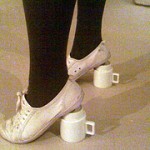In that stuck place of our all or nothing, black and white thinking, this phrase is uttered often, particularly when contemplating change. Having invested in a certain path, we think we must stay the course. For how long? Basically forever, it seems. This is how I hear it–again and again (and even have been known to utter it myself):
“But all those years in school to prepare me for this career! Seems like if I switch gears, all that is a waste.” (This seems particularly pressing when the speaker has student loans, but time invested is also important.)
“I’ve been in this relationship this long. How could I throw it all away?”
“We bought this house–or made this move–certainly we should hang in there. It would just be money down the drain.”
“I lost all this weight. It’s a shame to gain it all back. Guess I’ll just quit trying.”
This is one key moment to exclaim “who’s says?” I believe every path, every choice, every bit of time spent in any portion of our lives is an invaluable investment in shaping our lives. What have you learned in this open-to-question adventure? How has this lived experience brought you to where you need to be, launching you into the next step? There is no incorrect step, no perfect path. What you have done is the ideal preparation for what comes next.
Cognitive dissonance theory explains how our thinking automatically adapts to believe that wherever we are is THE RIGHT PLACE. That car you purchased, the house you bought, the partner you chose? Your brain wants equilibrium, so adapts to believe that there is a single correct choice. And that choice is where you are. The problem arises when this line of thinking prevents us from moving forward, growing, changing. Yes, we loved that first Commodore 64 computer! But it’s laughable today, when our phones contain more memory and power. To continue to stick with that device, just because it was the choice you made, would be a waste.
Unquestioningly, you would not be where you are now without those very steps that you are second-guessing or dismissing. No waste. Just what you needed to do, or learn, or live. Accepting where you are moving i’s just another way to practice self-compassion. Embrace it.





